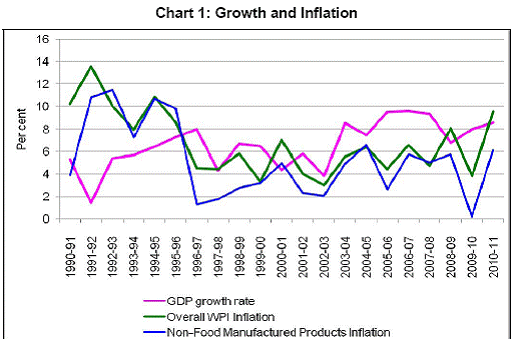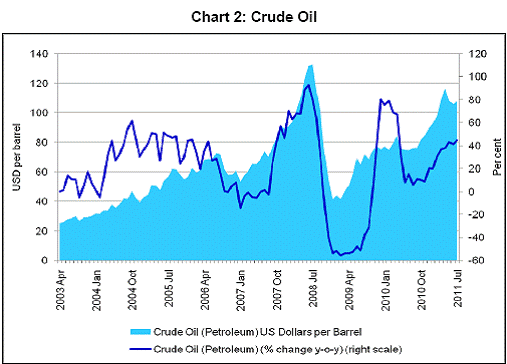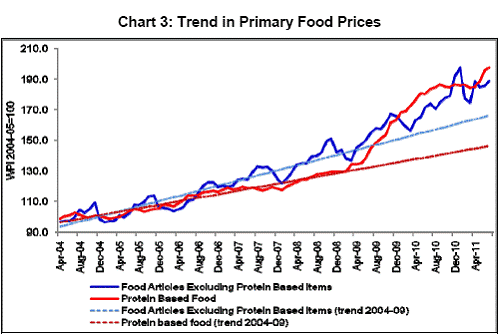 IST,
IST,


Monetary Policy: Key factors Shaping Trajectory
Dr. Subir Gokarn, Deputy Governor, Reserve Bank of India
delivered-on అక్టో 10, 2011
The core objectives of monetary policy in the future will remain what they have been in the past. The primary objective of monetary policy is a low and stable inflation. In achieving this, the economy has to be allowed to maintain growth at the highest possible rate consistent with a low and stable inflation. However, the context in which these objectives are pursued obviously changes over time. In my view, there are three key factors that are playing an important role in the current Indian context. Each of them has a bearing on both the monetary stance and the strength of the monetary transmission process. |
||||
 |
Non-inflationary rate of growth (NIRG) The first critical factor is the maximum rate of growth that the Indian economy can generate without provoking inflationary pressures. This notion is a core building block in monetary economics, though it is typically labelled the potential growth rate of the economy. The concept is very simple. If the economy is growing faster than its potential, capacities and resources are stretched. Producers and workers find it relatively easy to raise prices and wages in the face of buoyant demand for their goods and services. Rising prices across the board then translate into generalized or broad-based inflationary pressures. On the other hand, if the economy is growing below its potential, resources are idle, making it difficult for workers and producers to ask for higher wages or prices. Inflation is low and will remain so until the economy reaches its potential growth rate. The challenge for monetary policy, then, is to find and maintain a stance that keeps the economy as close as possible to its potential growth rate. Grow any faster and there is a risk of inflation becoming entrenched; grow any slower and growth is being needlessly sacrificed. |
|||
Do we know what India’s NIRG is? In the recent past, at what rates of growth have significant inflationary pressures been triggered? Looking back over the past two decades (see chart 1), we have three distinct episodes of accelerating inflation following a growth spurt. The first is in the mid-1990s, when inflation surged during a three-year period of growth slightly above 7%. The second is in the pre-crisis high-growth phase, when inflation around the middle of a five-year period of growth averaged over 8.5%. The third is in the post-crisis period, when rising inflation accompanied the recovery from a growth of 6.8% in 2008-09, the trough of the crisis, to 8% in the following year.
Two important implications for the future of monetary policy can be drawn from these three episodes. First, NIRG is not a long-term constant. It can change over relatively short periods of time, as it did from about 7% to about 8.5% in less than a decade, between the first and second episodes. Importantly, in the transition out of the crisis, when the growth rate accelerated from its low 6.7% in 2008-09 to 8% in 2009-10 and, further, to a currently estimated 8.5% in 2010-11, inflationary pressures quickly became quite strong. This might suggest that NIRG is now closer to 8%. Second, the increase in NIRG from 7% to 8.5% seems to have been accompanied by a sharp rise in the investment-GDP (gross domestic product) ratio and a steady decline in the fiscal deficit-GDP ratio. The former suggests that as new capacity is created in the economy, its ability to grow faster without spurring inflation increases. The latter suggests that for a given rate of growth, the composition of spending also matters. Less government borrowing appears to be associated with a rising NIRG, perhaps because it creates more space for investment. Of course, more analysis of these relationships is warranted, but they do suggest that monetary policy will have to take the overall composition of expenditure into account while assessing NIRG, which in turn will influence the policy stance. Impact of energy prices For energy-importing economies such as China and India, monetary policy is going to be influenced by global oil price movements as long as oil remains the predominant incremental source of energy. The same arguments hold for other important commodities as well, but energy is likely to be the most important factor, so I shall focus on it. Chart 2 demonstrates how important energy prices and their rate of inflation are to domestic inflation. During the economy’s pre-crisis high-growth phase, the crude oil price, though rising, was doing so relatively slowly.
As we saw in the earlier discussion, the domestic inflationary situation was relatively benign during this period. Just before the crisis, it rose sharply, driving domestic inflation to high levels, before crashing during the crisis, accompanied by a sharp fall in domestic inflation. Although it recovered from that low level quite strongly, it was still below $80 per barrel in October 2010. However, from November onwards, on that relatively high base, year-on-year increases of around 30% have clearly contributed significantly to the acceleration of inflation during the current year. In India’s current situation, as shown by the experience of the past few years, high and rising energy prices have a powerful impact on domestic macroeconomic conditions. If they continue to rise, they will have a negative impact on NIRG; in other words, in order to maintain a given rate of inflation, growth may have to slow. Even if they do not rise, high prices in absolute terms will have a bearing on the commercial viability of investments across the board. Investment activity may decline, contributing to a further erosion of NIRG. This perspective has a straightforward implication for monetary policy. When the economy is at or close to its NIRG, an increase in energy prices can trigger inflationary pressures, because there is high capacity utilization and producers can easily pass on higher energy prices to their consumers. A common argument in the current Indian policy debate is that since rising energy prices are a supply shock, monetary policy, which acts through its impact on demand, should not respond to this shock. It must be emphasized that this argument has merit only when the supply shock is transitory or temporary in nature. If its impact is likely to fade relatively quickly, a monetary policy response is not required. However, a persistent shock, which takes the prices of critical inputs to new highs and keeps them there, does warrant a monetary policy response. Essentially, to go back to the argument made a little earlier, high and rising energy prices may contribute to the lowering of NIRG and this needs to be recognized and acted upon, if inflation is not to get out of hand. Impact of food prices Years of experience have persuaded us that food price inflation is typically a temporary phenomenon, dependent on whether the monsoon has been good or bad. That this is no longer the case has been vividly demonstrated by the record over the past few years, when food price inflation has persisted despite reasonable monsoon performance in some of those years. The simple reason for this is that Indian households have begun to diversify their diets away from, predominantly, cereals to protein sources—pulses, milk, eggs, meat and fish—and vegetables and fruits. Chart 3 very clearly shows the sharp increase in the price trend of protein items.
The great consumer boom—mobile phones, television sets, air conditioners, motorcycles and other products—emerged out of sustained increases in the income levels of millions of households. There is no reason why, at relatively lower income levels, this should not be happening to food as well. In fact, the recently published Consumer Expenditure Survey carried out by the National Sample Survey Organisation in 2009-10 demonstrates how significant the shift from cereals to proteins has been in terms of its significance in household food budgets. The country went through a Green Revolution in the late 1960s and early 1970s, during which time cereal production was increased dramatically to satisfy demand. At this stage of development, the gap between rapidly rising demand and not-so-rapidly rising supply of proteins, vegetables and fruits have led to sustained increases in food inflation, which a good monsoon or two is simply not going to ease. Just as in the case of energy, an often-raised point is that monetary policy cannot directly address food inflation, so it has no role in responding to it. The response is the same. High and rising food prices in a situation where the economy is at or close to its NIRG do tend to work their way through wage contracts and, eventually, to rising prices across the board. Just as in the case of energy, persistently high and rising food prices adversely impact NIRG and, therefore, do warrant a monetary policy response. Concluding comments It is important to highlight the fact that the central bank is the only component of the policy establishment that has an explicit mandate for price stability or inflation management. Consequently, whatever other goals it may pursue, these must be aligned to this primary mandate. This uniqueness will continue to determine the future trajectory of monetary policy. However, other components of the policy establishment have mandates that may indirectly impinge on inflation. In particular, as was illustrated above with reference to food, but is also relevant to other potential bottlenecks, policy initiatives that induce additional supply help to raise NIRG. This means that any given inflation rate will now be consistent with faster growth, or alternatively, any given growth rate will be consistent with a lower inflation rate. From this perspective, the monetary policy stance will be influenced by an assessment of how NIRG itself is being shaped by public and private investment activity and other policy measures, as well as global developments, including, importantly, trends in commodity prices. Finally, there is a new set of considerations emerging after the crisis, which I did not have the space to go into here. Perhaps the most important of these is the issue of financial stability and how it should be integrated into the broader regulatory mandate and, more narrowly, into the central bank mandate. This is an evolving global debate and it is too early to say how it will impact monetary policy directly, but it is certainly something to watch out for. Copyright HT Media Ltd. |
||||
పేజీ చివరిగా అప్డేట్ చేయబడిన తేదీ:





















